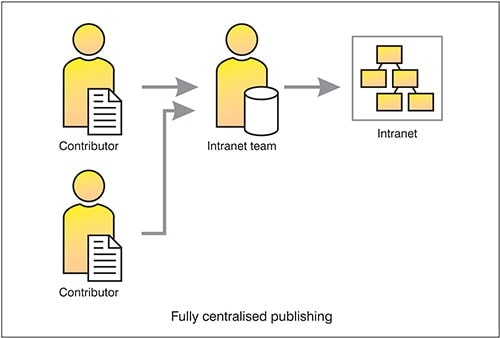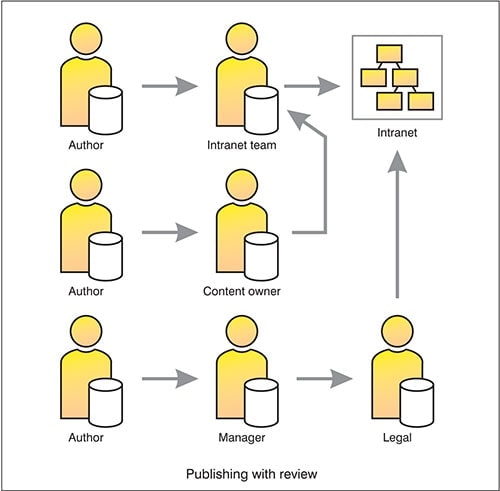
Digital printing from Shutterstock
Filed under: Articles, Intranets
Intranets can grow to be thousands, tens of thousands or millions of pages in size. With content as far as the eye can see, the challenge is to keep it up to date, accurate and useful.
Sitting behind this huge volume of content are a wide range of approaches to creating and publishing pages.
The central team has a clear role to play in managing this content, as do publishing guidelines and intranet governance documents.
Yet the central team alone cannot manage thousands of pages, and a decentralised publishing model is established to give business areas responsibility for maintaining their own content. New authors do, however, require support and training.
Against this backdrop of ‘traditional’ publishing models, the growth of web 2.0 and ‘user-generated content’ is raising new questions about how to maintain an intranet.
The key challenge is to establish the right mix of publishing models, flexible in many cases, rigid in others. The intranet team needs to manage the overall process, including adjusting approaches when circumstances change.
This article explores five fundamental publishing models for intranets, providing a description of each, and a brief summary of strengths and weaknesses.
Use these models as the starting point for discussions with authors and stakeholders, and put in place a balanced mix of publishing approaches that deliver the best standard of content within resource constraints.
There is no one ‘perfect’ intranet publishing model
Five publishing models
This article will explore five fundamental publishing models commonly used on intranets:
- Fully centralised publishing. All content is published by the central intranet team, with business areas contributing information via email, Word documents and other source documents.
- Decentralised publishing. Business areas are responsible for publishing and managing their own content. Authors in each business area can publish directly to the intranet.
- Publishing with review. Content is produced by authors within business areas, but goes through some form of review before it is published to the intranet.
- Federated publishing. A hybrid model is followed, with each business area appointing a coordinator who takes responsibility for managing intranet authors within their area.
- End-user content contribution. Staff across the organisation can contribute news items or content to the site directly, without a formal role as an ‘author’.
Each of these approaches offers strengths and weaknesses, and there is no one ‘right’ publishing model. In practice, a mix of approaches will be taken.
It is important that intranet teams pay particular attention to the effort required to publish content in each model. Use ‘heavyweight’ centralised approaches sparingly, relying on decentralised approaches wherever possible.
Each of these publishing models will be discussed in the coming pages.
1. Fully centralised publishing

A central intranet team is established, which takes on responsibility for publishing and managing content on the site. As shown above, business areas contribute information via email, Word documents and other source documents.
The central team takes the source information, and reworks it to match intranet requirements. A formal or informal sign-off is obtained from the business area before the content is published.
The central team also has direct responsibility for a number of areas of the intranet. This will certainly include top-level pages of the site, and may also extend to key areas of the site such as human resources.
At the most extreme, some intranet teams have almost complete responsibility for the intranet, with only limited involvement from the business.
Strengths of this approach:
- ensures content quality
- ensures intranet consistency
- minimises training required
- simplifies publishing technology requirements, as publishing is done by a central team of skilled authors
- provides consistent resources for updates
Weaknesses of this approach:
- becomes a bottleneck
- produces content that may not be written for the web, as source material is provided as documents
- limits subject matter expertise
- limits engagement from business areas
- has zero cost for business areas, making it too easy to publish excessive volumes of content
In practice, fully centralised publishing isn’t scalable, and inevitably becomes a bottleneck. As such, it’s not a viable approach for maintaining all of a large and vibrant intranet.
The effort involved in centrally publishing content may also be excessive for lower-value content.
Intranet teams must be wary of using all of their time maintaining content, which limits their time (and resources) for other intranet activities.
Intranet teams should therefore focus centralised publishing approaches on:
- top-level sections of the site
- key information resources
- business areas without sufficient resources
- business areas that publish infrequently
2. Decentralised publishing

Decentralised publishing puts the responsibility for creating and maintaining intranet content into the hands of authors situated in business units across the organisation.
In this model, shown above, authors can publish directly to the intranet, typically only within the sections of the intranet that they own.
In large organisations, decentralised publishing can grow to encompass hundreds of authors across every major business unit. In turn, this can generate tens of thousands of intranet pages, covering every aspect of the organisation.
To be fully effective, authors need to be provided with simple publishing tools, eliminating the need to understand HTML coding. A web content management system (CMS) or equivalent will typically be used to provide this simple publishing capability.
Decentralised publishing offers a number of advantages:
- harnesses the efforts of many authors
- scales better for large organisations
- gives responsibility to business units
- may provide more up-to-date content
- integrates content creation into business activities
There are also a number of disadvantages:
- produces uneven content quality
- makes consistency harder to achieve
- can be difficult to sustain effort
- becomes chaotic unless well managed
- needs good publishing tools
- generates a significant support burden for the centralised team
Decentralised authoring is required for any large intranet, as there is no other practical way of maintaining the site as a whole. It is also important to foster a strong sense of content ownership amongst business units.
Good management and support of decentralised authoring will be required to mitigate some of the common problems encountered on intranets.
In practice, the central intranet team should provide strong support and mentoring for decentralised authoring. This should include up-front formal training, followed by ongoing skills development.
To be fully successful, intranet authoring and publishing responsibilities need to be included in formal position descriptions for staff.
This ensures that staff are given enough time to maintain their content, as well as helping to select appropriate replacement authors when staff move between areas.
3. Publishing with review

In this approach, content is produced by decentralised authors within business areas, but is reviewed before being published to the intranet.
As shown above, these reviews may take a number of forms, including a final quality check by the intranet team, review by content owners in business areas, sign-off by business managers or review by legal.
There are a number of advantages of publishing with review:
- ensures content is double-checked
- improves consistency and quality of content
- can catch mistakes
- improves accountability
- allows intranet team to keep track of changes
There are also a number of disadvantages:
- requires additional effort
- can overwhelm the central team
- reduces speed of publishing
- can create bottlenecks
- may lead to limited reviews that only check for consistency not accuracy
Review processes require time and resources devoted to them, both from the central team and decentralised areas.
They also have the potential to slow down publishing and create bottlenecks. Even when automated via CMS workflow capabilities, review processes can be cumbersome.
Review processes may not be required for much of the content on the intranet. While reviews are a necessity on public-facing websites, intranets may benefit from being used and updated more frequently, rather than relying on pre-publishing reviews.
4. Federated publishing

As shown in above, federated publishing involves business areas appointing a ‘coordinator’ who takes responsibility for managing intranet authors within their area.
(In practice, this role is given many different names across organisations.)
The effect is to create the equivalent of a ‘mini intranet team’ within major business units, with the central team working closely with the coordinators. In a part-time or full- time capacity, the local coordinators plan, manage and review intranet activities for their business area.
A mix of authoring approaches can then be used within the business area. This includes having decentralised authors publish content that is reviewed by the coordinator, as well as content contributors providing source material for the coordinator to publish.
This model offers a number of advantages:
- builds expertise within key business units
- offers a hybrid approach
- gathers a smaller number of people for the central team to work with
- reduces the load on the central team
- scales well
There are also some disadvantages:
- requires business units to devote more resources
- coordinators must be qualified
- still requires strong management
The federated publishing model is almost certainly necessary in larger organisations, and it matches the devolved nature of these organisations.
Like the other models, this requires good overall coordination and management or it will lead to large ‘silos’ of intranet content.
Federated publishing should only be applied to larger business areas that can afford to appropriately resource their coordinators.
Mandating the universal rollout of the federated model will only lead to many out-of-date sections of the intranet, owned by business areas which lack the skill or time to better maintain their content.
Intranet teams should work closely with coordinators to build and sustain their skills, as well as to assist on key projects. For example, the central team would be closely involved in a major redesign of the HR section of the intranet.
Also establish a regular meeting of the coordinators, to allow them to share information, and to provide peer support. This should be facilitated online if the coordinators are widely spread geographically.
5. End-user content contribution

In addition to having appointed authors using back-end publishing tools to create intranet content, staff across the organisation can contribute news items or content to the site directly.
As shown in above, this type of end-user content contribution can work in a variety of ways, including contributing via forms (such as for news items), editing wiki pages, or posting blog entries.
This is the ‘user-generated content’ highlighted by web 2.0 advocates, and it has the potential to reshape intranets.
Note that where appropriate, content contributed by staff can be reviewed, using any of the approaches outlined earlier. For example, staff-submitted news items could be double-checked by the communications team before they are released.
This model offers a number of benefits:
- allows for broad staff engagement
- allows information to be published instantly
- addresses different content needs, not typically covered by formalised publishing
- remains simple for content contributors
- allows content to grow organically
There are also a number of challenges:
- has potential for poor quality content
- needs to differentiate user-generated from reviewed content
- produces content that is less structured and consistent
- may expose organisation to business risks
End-user content contribution is a large topic, and organisations are only in the early stages of exploring how it works in practice.
In many cases, this type of publishing is limited to collaboration areas, although a few organisations have reworked their entire intranet to be based on direct publishing.
The good news is that fears of inappropriate content or legal issues have largely proven to be unfounded, even in widespread use.
While much more could be said, there are a few key areas where immediate benefits can be gained:
- publishing news and other timely updates
- supporting local content publishing
- building knowledge bases
- supporting two-way communication
Intranet teams should take opportunities to experiment with this publishing model, allowing greater participation from staff.
Picking the right models
With the diversity of approaches to intranet publishing, it is important to pick the right mix of models to match the organisation’s culture and needs. Follow these guidelines:
- No one-size-fits-all approach. There is no single model that can be applied across the whole organisation. A mix of approaches should be used, tailored to fit individual circumstances.
- Mix and match. Elements from each of the basic models outlined above can be combined into dozens of different hybrid approaches. Don’t be afraid to experiment, and to work with authors to identify new approaches.
- Match to the importance of the content. More robust models require greater time and effort, and these should be targeted to the most important content. Lower value content can be directly published, or managed more lightly.
- Fit to the skills and time of the authors. Less experienced authors will require greater support, up to and including publishing content on their behalf. Smaller business areas may also require greater support.
- Be flexible and adapt over time. Publishing approaches should be adjusted over time to reflect changing circumstances. For example, centralised publishing may be used for a smaller business unit until they can obtain further resources, when a switch is made to a federated model.
Don’t be afraid to experiment with approaches, and always focus on supporting staff who have been given publishing responsibility. At the end of the day, good content is a people issue, not a governance or technology problem.
Summary
Intranets contain a considerable volume of valuable content, but the ever-present challenge is to keep this sea of pages of up to date.
There is no one-size-fits-all solution that will ensure that content is well managed. Instead, a mix of approaches to authoring and publishing content will be required.
This article has explored five fundamental publishing models:
- fully centralised publishing
- decentralised publishing
- publishing with review
- federated publishing
- end-user content contribution
Each of these has strengths and weaknesses, and their applicability will vary from organisation to organisation, and between business units.
Use the more robust approaches, such as centralised or reviewed publishing, only when the value of content warrants it.
For other content, devolve responsibility out to the organisation, following a decentralised, federated, or user-generated approach.
This will ensure that the limited resources of authors and the central intranet team are devoted to the highest value content.





